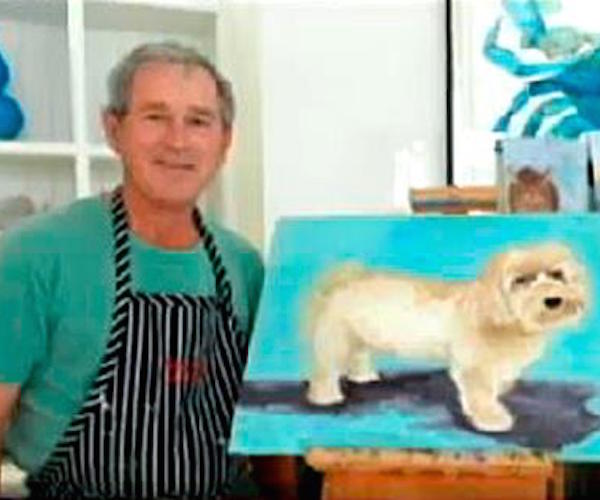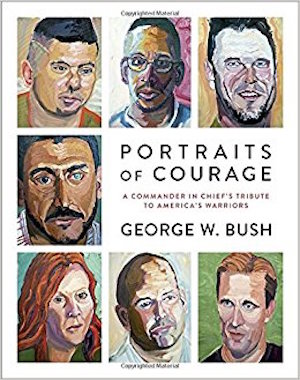Visual Arts Commentary: “Portraits of Courage” — Critical Misfire
Why do critics like the New Yorker‘s Peter Schjeldahl rush to absolve G.W. Bush?

Former President George W. Bush proudly displaying his art. Photo: YouTube.
By Harvey Blume
In a recent commentary on The Arts Fuse, Editor Bill Marx hones in on “the craven foolishness of my fellow [theater] critics.”
The rot Marx espies isn’t limited to theater criticism. A more insidious version of the same has infected art critics.
Consider, if you will, the approval afforded G.W. Bush’s book of truly mediocre paintings collected in his volume Portraits of Courage: A Commander in Chief’s Tribute to America’s Warriors. Peter Schjeldahl, the New Yorker‘s estimable art critic, responded to the book by writing, “Having obliviously made murderous errors, Bush now obliviously atones for them.”
The problem is there is no evidence of atonement in the book. That atonement is all in Schjeldahl’s head, not a hint of it in Bush’s. If anything, the text accompanying and introducing these paintings doubles down on and reaffirms the virtue of invading Iraq, which led to the terrible wounding of the soldiers whose condition Bush paints at a safe distance, purely from photographs. Sometimes, in these tepid efforts a wheelchair can be seen and, in one case, a prosthetic arm.

General Peter Pace in his foreword to the volume writes that in meetings about combat in Iraq and Afghanistan, President Bush “asked tough questions, and continued to ask them until he had all the information he needed. . . Then, once he made a decision, he would resource it properly and do whatever it took to support those he had charged with carrying it out. . . you couldn’t have asked for a better Commander in Chief.”
What an intolerable lie this is.The George Bush who attended those meetings never knew, for example, that Islam was perilously divided between Shi’ism, and Sunnism, never knew, never wanted to know, was incapable of knowing, the forces he was releasing by invading Iraq. By now it’s clear the invasion of Iraq reduced it to a failed state and elevated the Sunni – Shiite split to a new level of viciousness. ISIS is a result of the destruction of Iraq, ISIS and with it the wars that have generated a refugee crisis that embroils not only the Middle East but the democracies of the west.
George Bush never knew, still doesn’t, can’t.
My question is: Why do critics like Schjeldahl rush to absolve him?
Is it because anything, even G.W. Bush, looks good in the age of Trump? Or is it something deeper and more fundamental, namely that our art critics have no idea how to traverse from politics to aesthetics. If they ever did, they’ve lost the skill long ago and wind up being politically and aesthetically abject.
Why have none of these critics asked why Bush did not include a single wounded Iraqi in his gallery of the wounded, and why not a maimed or fleeing refugee or refugee family?
There’s no evidence of atonement in this book. It’s the critics who have imputed absent virtues to G.W. Bush who have something to atone for — unless that’s beyond them too.
Harvey Blume is an author—Ota Benga: The Pygmy At The Zoo—who has published essays, reviews, and interviews widely, in The New York Times, Boston Globe, Agni, The American Prospect, and The Forward, among other venues. His blog in progress, which will archive that material and be a platform for new, is here. He contributes regularly to The Arts Fuse, and wants to help it continue to grow into a critical voice to be reckoned with.
Tagged: George W. Bush, Iraqi War, Peter Schjeldahl, Profiles of Courage

A needed response to a probably flippant remark by the New Yorker critic, who most likely didn’t bother reading the text after looking at Bush’s goofy, Museum of Bad art paintings. But, Harvey, you say “critics” in your attack, yet you provide only one stupid sentence by one critic to stand for all of them. I wonder if your thesis would hold up with the various reviews of Bush The Artist. Maybe, maybe not.